Newsletters
- Home
- Publications
- Newsletter Archive
- Newsletter
September/October 2015
Inside This Issue:
- Center Concludes Public Hearings on Heroin Addiction Treatment, Recovery Services
- Chairman's Message
- Rural Snapshot: First-Time Homebuyers in Pennsylvania
- Research Examines Special Education Funding, Enrollments and Expenditures
- Just the Facts: Recycling
Center Concludes Public Hearings on Heroin Addiction Treatment, Recovery Services
The number of fatal heroin overdoses has been steadily increasing in Pennsylvania.
A 2014 report from the Pennsylvania State Coroners Association indicated that 2,489 individuals died from drug-related causes in 2014, a 20 percent increase from 2013. The association also reported that initial data from 2015 indicate the number of deaths will continue to increase. Other states across the nation are reporting an increase in heroin use, as well, as addicts are shifting from more costly prescription opioids to cheaper alternatives.
“The heroin crisis has reached epidemic proportions, and has taken center stage on the local, state and national levels,” said Sen. Gene Yaw, Center for Rural Pennsylvania board chairman, at the last of three public hearings on heroin and opioid addiction treatment and services sponsored by the Center this past summer. “The Center has taken a leadership role to educate policymakers, inform the public, and enhance current policies in Pennsylvania related to heroin and opioid addiction treatment.”
Over the past two summers, the Center conducted seven public hearings and received more than 30 hours of verbal testimony and 350 pages of written testimony from 90 presenters.
The three hearings conducted this summer were held at Saint Vincent College in Latrobe, The Commonwealth Medical College in Scranton, and the Yorktowne Hotel in York. Presenters included state officials, law enforcement officials, educators, and state and local treatment service providers.
“Our efforts are aimed at finding ways to better administer prevention, recovery and treatment options and learn more about what law enforcement can do,” said Sen. John Wozniak, Center board vice chairman.
Dr. Nancy Falvo of Clarion University and Center board secretary said, “Through these hearings, we are increasing awareness of this complex issue and how it affects individuals living with the disease of addiction, their families and their communities. As a nurse and an educator, I am thrilled that the Center’s hearings, held in both rural and urban communities of Pennsylvania, are helping to provide a clearer picture of this public health crisis.”
This fall, the Center will provide the General Assembly with a summary of the hearings and suggestions for legislative policies that address treatment and recovery services.
For more information on the hearings, visit http://www.rural.palegislature.us/publications_heroin_and_opioid_addiction_public_hearings.html#082015. Copies of the testimony submitted by presenters are available at Sen. Yaw’s website at www.senatorgeneyaw.com/heroin-combating-this-growing-epidemic-in-rural-pennsylvania/.

Deb Beck, president, Drug and Alcohol Service Providers Organization of Pennsylvania, and Secretary Gary Tennis,
Pennsylvania Department of Drug and Alcohol Programs, present testimony to the Center for Rural Pennsylvania Board of Directors
and area legislators at the York public hearing on heroin addiction treatment and recovery services.
Saint Vincent College, Latrobe

Pictured from top left: Dr. Eric Kocian, assistant professor, Criminology, Law and Society,
Saint Vincent College; Kami Anderson, executive director, Armstrong-Clarion-Indiana Drug and Alcohol Commission;
Sen. Patrick Stefano; Dr. Nancy Falvo, Barry Denk, Sen. Gene Yaw, Sen. John Wozniak, Rep. Garth Everett, and Sen Kim Ward.
The Commonwealth Medical College, Scranton

Pictured from top, left to right: Pennsylvania Physician General Dr. Rachel Levine;
Pennsylvania Department of Human Services Secretary Ted Dallas;
Sen. Lisa Baker, Rep. Sid Michaels Kavulich, Dr. Falvo, Mr. Denk, Sen. Yaw; Sen. Wozniak, Rep. Garth Everett;
Rep. Karen Boback, Sen. Mario Scavello;
Rep. Sandra Major; Sen. Judy Schwank, Sen. Baker;
and Dr. Margaret Jarvis, medical director, Geisinger Health System.
The Yorktowne Hotel, York

Pictured from top, left to right: April Billett Barclay, York County Adult Probation Department chief;
Dr. Kenneth Martz, Pennsylvania Department of
Drug and Alcohol Programs; Rep. Seth Grove, Rep. Kate Klunk,
Dr. Stephan Goetz, Dr. Livingston Alexander, Dr. Ted Alter, Steve Brame,
Dr. Karen Whitney,
Rep. Kevin Schreiber, Rep. Kristin Phillips-Hill, Sen. Scott Wagner, Dr. Falvo, Mr. Denk, Sen. Yaw,
Sen. Wozniak, Rep. Kavulich, Sen. Pat Vance,
Sen. Mike Folmer; Dr. Lauren Hughes, Deputy Secretary for Health Innovation,
Pennsylvania Department of Health;
and Jack Carroll, executive director, Cumberland/Perry Drug and Alcohol Commission.
Chairman's Message
In this latest round of public hearings on heroin and opioid addiction sponsored by the Center for Rural Pennsylvania, I was struck by the powerful testimony of Delaware County District Attorney Jack Whelan, who presented at the York hearing. I want to share some of his comments with you.
DA Whelan discussed his county’s response to the alarming number of heroin-related deaths that started as far back as 2007. The county formed a Heroin Task Force in 2012, started a school-based program called “Realities of Prescription Drugs and Heroin Abuse,” and also formed a Narcotics Overdose and Prevention and Education Task Force to provide additional outreach to schools.
DA Whelan then noted his county’s overwhelming support for Act 139 of 2014, known as David’s Law, which permitted all first responders, including law enforcement, to carry Naloxone, a medication used to reverse opioid overdose. He said that when the law went into effect on November 29, 2014, Delaware County was ready to put the 900 doses of nasal Naloxone into the hands of its police officers, and put two doses in every Delaware County police vehicle.
Almost immediately, Ridley Township Patrolman Shawn McGee, who also testified at the York hearing, became the first law enforcement officer €“ possibly in the state €“ to administer Naloxone under David’s Law. DA Whelan followed that up by saying Delaware County has made 81 saves with Naloxone since the law went into effect. He also said that, because of the limited immunity David’s Law provides to those who report a drug overdose to authorities, he believes this “Good Samaritan” portion of the law will also save lives.
As you may recall, the Center worked with the Pennsylvania Department of Drug and Alcohol Programs on a study of local police departments and their use of naloxone earlier this summer. The survey found there was a need for this life-saving medication to be available to all first responders as a majority of local police departments said they responded to overdose calls within the past 12 months. The Center also issued a report summarizing the testimony from the first four public hearings on heroin/opioid addiction last summer, which noted the support for David’s Law, and the need for more work in terms of treatment, education, prevention and law enforcement.
Once again, the Center will be summarizing the testimony from this last round of hearings and publishing a report this fall. As DA Whelan said, legislation will not solve all of the issues surrounding the heroin/opioid crisis, but continued focus on education and prevention programs and mental health and substance abuse treatment will go a long way to combating this public health crisis.
Senator Gene Yaw
Rural Snapshot: First-Time Homebuyers in Pennsylvania
About this Snapshot
This snapshot focuses on first-time homebuyers. It used data from the Federal Housing Finance Agency (FHFA), Enterprise Public Use Database, Single-Family Properties, Census Tract File. FHFA collects information on the number of mortgages acquired each year by Fannie Mae and Freddie Mac. The data include the borrower’s age, gender, race and income and the amount borrowed or Unpaid Principal Balance. The data also indicate the purpose of the mortgage (home purchases, refinancing, or investment) and whether the borrower is a first-time buyer, which FHFA defines as a homebuyer who intends to live in the purchased home and who has not owned a home in the past 3 years.
For the fact sheet, First-Time Homebuyers in Rural and Urban Pennsylvania, visit http://www.rural.palegislature.us/publications_fact_sheets.html.
Rural and Urban Homebuyers, 2013
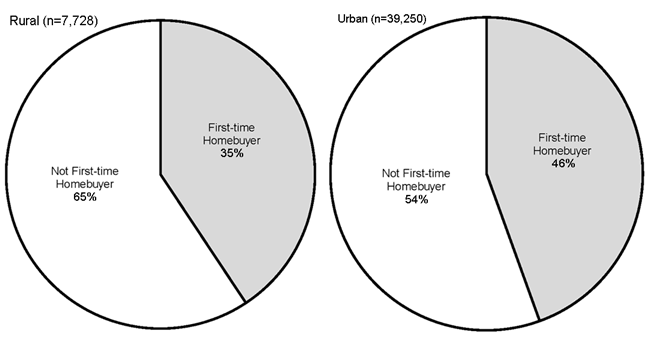
First-time Homebuyers in Pennsylvania, 2010 to 2013
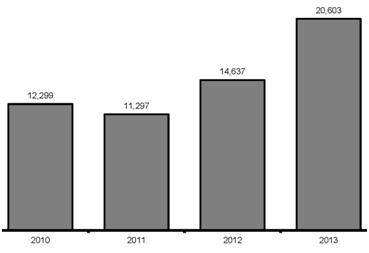
Age of Rural and Urban First-time Homebuyers, 2013*

*Percentages only include the age of the first person listed on the mortgage.
First-time Homebuyers by Census Tract, 2013
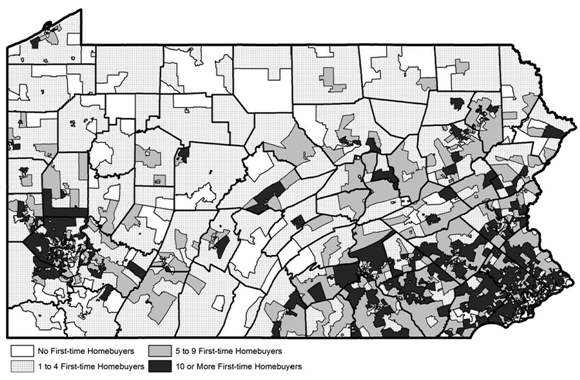
Income of First-time Rural and Urban Homebuyers, 2013
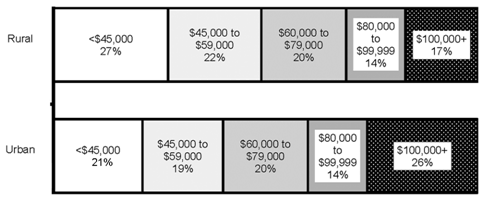
Amount Borrowed (UPB) by First-time Rural and Urban Homebuyers, 2013
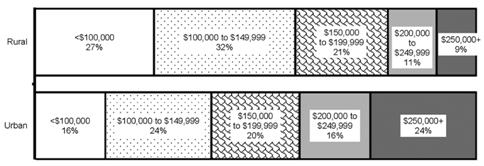
FHFA records the amount of money borrowed to purchase the home. Called the €œacquisition of Unpaid Principal Balance€ (UPB),
this amount is not the same as the selling price of the home since it excludes any down payments and closing costs.
Research Examines Special Education Funding, Enrollments and Expenditures
Research examining special education enrollments, expenditures and revenues in rural and urban Pennsylvania school districts and charter schools over the 10-year period of 2002-03 to 2012-13 found that state subsidies and federal funding for special education each increased approximately $140 million over the study period while local funding rose by $1.3 billion.
The research, conducted by Dr. William Hartman of Penn State University and sponsored by the Center for Rural Pennsylvania, indicated that the state share of funding dropped from 42 percent to 27 percent over the study period. The federal share rose slightly from 3 percent to 5 percent, and the local share increased from 56 percent to 68 percent of total special education revenues. What was essentially an equal state/local partnership in 2002-03 changed to where the state is a minor partner and local districts have become major partners. The direct fiscal impact has been a shift of funding of more than $500 million from prior levels of state support to local districts.
Enrollments
The research, which used financial and enrollment data from the Pennsylvania Department of Education, also found that, overall, special education enrollments were essentially stable over the study period, growing by only 4,800 pupils (1.8 percent) from a base of approximately 270,000 enrollments. District enrollments declined by almost 8,000 students while charter school enrollment increased by 12,800. Although charter school special education enrollments increased rapidly, charter schools still served only 7 percent of all special education pupils.
Special education enrollments declined more so in rural school districts (7 percent) than in urban school districts (1.6 percent).
Expenditures
Reported special education expenditures grew from $1.9 billion in 2002-03 to about $3.5 billion in 2012-13, an 82 percent increase. Rural districts showed a $300 million increase (69 percent) over this time, while urban districts showed a greater increase ($1.3 billion) and percent gain (86 percent). Concurrently, special education expenditures took a greater share of total school district expenditures, rising from approximately 10 percent to 12.4 percent for all districts, with special education in urban districts consistently having a higher share of total expenditures than rural districts.
However, not all reported special education expenditures were made by school-district-operated programs: tuition payments to charter schools for district special education students are reported as district expenditures. Of the tuition payments to charter schools by school districts, less than half of the total amount was reported by charter schools as being spent for instruction and support services for special education students. In 2012-13, for example, about $150 million (43 percent) of the total tuition payments of $350 million received by charter schools from school districts was reported for special education instruction and support services.
Conclusions
One issue to consider is the increasing fiscal burden on school districts of having to support almost all of the annual increases in special education expenditures. Enrollments are not under the control of school districts, as they are obligated to serve all special education students that enroll in the district.
Expenditures for special education students are largely driven by instructional programming specified in each student’s Individual Educational Plan. Consequently, changes in state policy to increase funding levels through state subsidies are the most likely avenue to reduce the current local burden.
Therefore, a policy consideration would be to maintain the state share of funding for special education and preferably increase the state share over time. However, implementation of this consideration is constricted by the state’s fiscal situation. On the other hand, continuing the current approach, with decreased state participation and little increase from federal sources, will result in even greater fiscal burdens on school districts.
For a copy of the research results, Analysis of Special Education Enrollments and Funding in Pennsylvania Rural and Urban School Districts, visit http://www.rural.palegislature.us/publications_reports.html.
Just the Facts: Recycling
Data from the Pennsylvania Department of Environmental Protection (DEP) indicate that, in 2013, rural residents and businesses recycled 1.08 million tons of plastic bottles, newspapers, aluminum cans and other recyclable items. Per capita, that’s about 628 pounds of recycled items per person.
From 2010 to 2013, rural recycling declined by 145,100 tons, or 12 percent.
DEP data show that urban Pennsylvanians recycled 5.03 million tons of items, or 1,080 pounds per person.
From 2010 to 2013, urban recycling increased by 732,800 tons or 17 percent.
Among some of the items rural residents and businesses recycled in 2013 were: aluminum cans at 5,200 tons; E-waste, which is computers, TVs and other electronic goods, at 4,500 tons; glass bottles at 15,400 tons; plastic items at 22,300 tons; and newspaper at 24,200 tons.
The three counties with the highest number of pounds recycled per capita were Beaver, Chester, and Schuylkill, each with more than 2,000 pounds per person.
Greene and McKean counties had the lowest number of pounds recycled, with less than 50 pounds per person. No data were reported for Forest County.
Pounds per Capita of Recycled Items in Pennsylvania, 2013
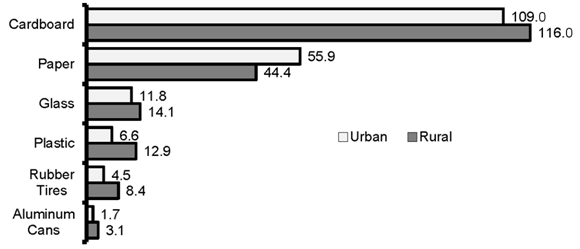
Items include both residential and commercial. Data source: Pennsylvania Department of Environmental Protection.
